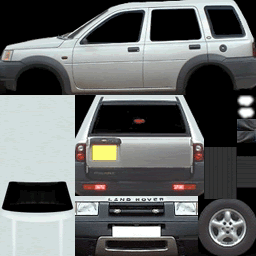

Creating one side of the carPreparation:
Process:
|
Play movie (500k) |
Extruding the 2D side to make a 3D car body
|
Play movie (800k) |
Using the Texture Coordinate Editor (TCE)to position the texture on the body
|
Play movie (3.8 meg) |
|
This is the texture image used in this movie. Note that this is a gif file which offers less quality than a jpeg due to the limited range of colors available.
to save this image, right click on it and select 'save as...'. |
 |
More time can be taken when creating the car sides to form more polygons (thus allowing the sides of the car to be adjusted and have a curve incorporated). The wheel arches are also not very detailed - more vertices could be inserted.
When extruding, the number of segments is set to one. Higher values would allow more of a curved shape to be added to the top, front and rear of the car.( Extra surfaces could be inserted to the current model by selecting those surfaces and using Surface->Divide. Moving the new points would add more of a 'curve' the the vehicles shape.)
The two polygons that are initially created are seperate objects and have been merged (Object->merge),then the object vertices have been shared (by using object->optimize vertices). This puts all the surfaces into a single object and ensures that there were no duplicated vertices.
The bottom surfaces of the car have not been mapped in this example. There are also other unused parts of the texture map e.g. mirrors and wheels. Wheels can be made simply by extruding a disk (or an Ellipse set to surface type 'Poly').